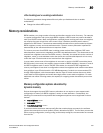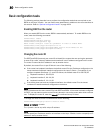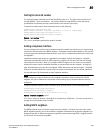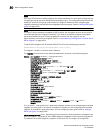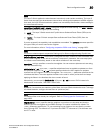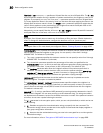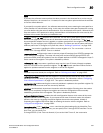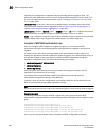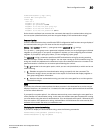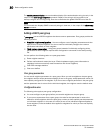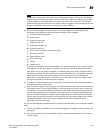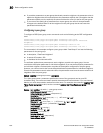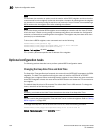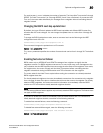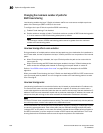
PowerConnect B-Series FCX Configuration Guide 999
53-1002266-01
Basic configuration tasks
30
Notice that the software has converted the commands that specify an authentication string into
the new syntax (described below), and has encrypted display of the authentication strings.
Command syntax
Since the default behavior does not affect the BGP4 configuration itself but does encrypt display of
the authentication string, the CLI does not list the encryption options.
Syntax: [no] neighbor <ip-addr> | <peer-group-name> password [0 | 1] <string>
The <ip-addr> | <peer-group-name> parameter indicates whether you are configuring an individual
neighbor or a peer group. If you specify a neighbor IP address, you are configuring that individual
neighbor. If you specify a peer group name, you are configuring a peer group.
The password <string> parameter specifies an MD5 authentication string for securing sessions
between the Layer 3 Switch and the neighbor. You can enter a string up to 80 characters long. The
string can contain any alphanumeric characters, but the first character cannot be a number. If the
password contains a number, do not enter a space following the number.
The 0 | 1 parameter is the encryption option, which you can omit (the default) or which can be one
of the following:
• 0 – Disables encryption for the authentication string you specify with the command. The
password or string is shown as clear text in the output of commands that display neighbor or
peer group configuration information.
• 1 – Assumes that the authentication string you enter is the encrypted form, and decrypts the
value before using it.
NOTE
If you want the software to assume that the value you enter is the clear-text form, and to encrypt
display of that form, do not enter 0 or 1. Instead, omit the encryption option and allow the software
to use the default behavior.
If you specify encryption option 1, the software assumes that you are entering the encrypted form
of the password or authentication string. In this case, the software decrypts the password or string
you enter before using the value for authentication. If you accidentally enter option 1 followed by the
clear-text version of the password or string, authentication will fail because the value used by the
software will not match the value you intended to use.
Displaying the Authentication String
If you want to display the authentication string, enter the following commands.
PowerConnect(config)#enable password-display
PowerConnect#show ip bgp neighbors
PowerConnect#show ip bgp config
Current BGP configuration:
router bgp
local-as 2
neighbor xyz peer-group
neighbor xyz password 1 $!2d
neighbor 10.10.200.102 peer-group xyz
neighbor 10.10.200.102 remote-as 1
neighbor 10.10.200.102 password 1 $on-o



